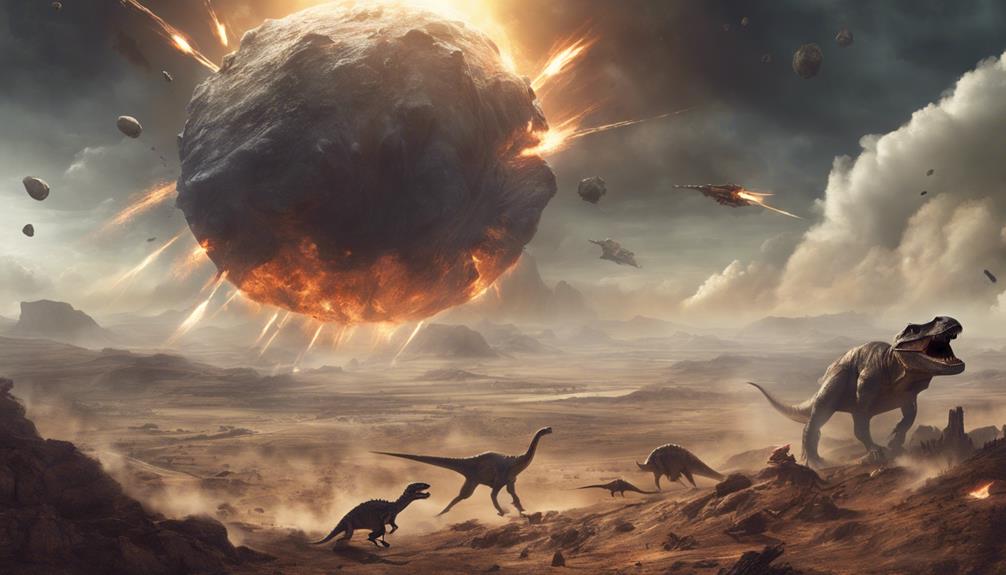The extinction of dinosaurs has long been a subject of scientific inquiry, with researchers exploring various hypotheses to unravel this ancient mystery. While the impact of an asteroid at the K-Pg boundary is a leading theory, recent studies have shed light on additional factors that may have contributed to the demise of these magnificent creatures. From volcanic eruptions to shifting climates, a complex interplay of events appears to have shaped the fate of dinosaurs. As we delve deeper into the past, new discoveries continue to challenge our understanding of this enigmatic chapter in Earth's history.
Key Takeaways
- Massive asteroid collision, evidenced by iridium levels and Chicxulub crater, triggered catastrophic events.
- Environmental devastation from impact caused global disruptions, leading to dinosaur extinction.
- Combined effects of asteroid collision and Deccan Traps eruptions altered ecosystems drastically.
- Post-extinction, evolutionary changes allowed mammals and birds to dominate, shaping modern biodiversity.
Theories on Dinosaur Extinction
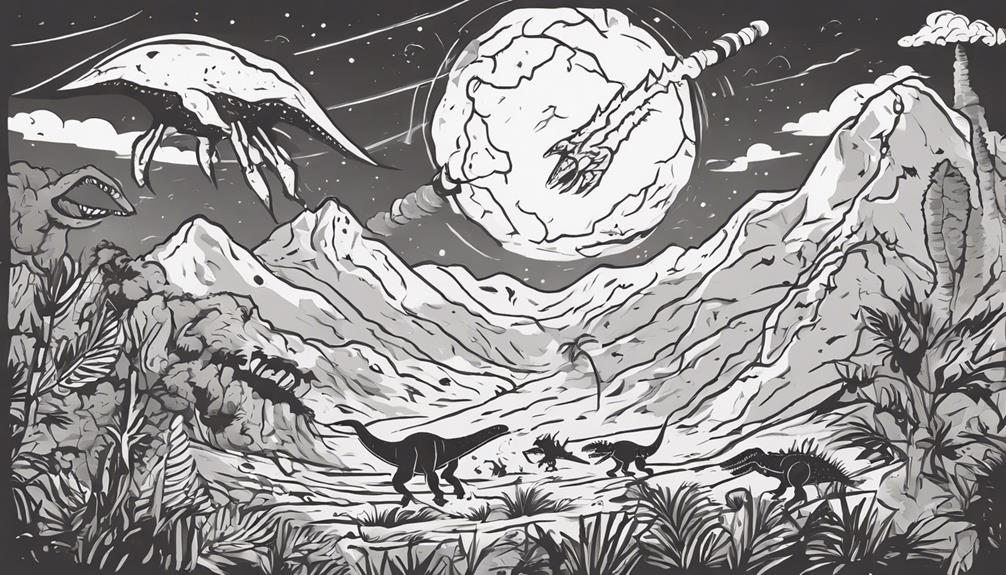
Exploring the various theories surrounding the extinction of dinosaurs reveals contrasting perspectives on the cataclysmic event's root cause. One prominent theory is the Alvarez hypothesis, which suggests that a massive meteor impact was the primary driver of the dinosaur extinction. This hypothesis gained significant support due to the discovery of high levels of iridium in the K-Pg layer, a marker of extraterrestrial impact. The Chicxulub crater in Mexico further bolsters this theory as it aligns with the timeline of the dinosaur extinction event. Drill core samples from Chicxulub provide compelling evidence in the form of vaporized rock and gases resulting from the impact. Additionally, the presence of fossils with tektites near the K-Pg boundary indicates the aftermath of a meteor impact, supporting the mass extinction of dinosaurs due to a catastrophic event like a meteor collision. The meteor impact theory, with the Chicxulub crater as a focal point, offers a compelling explanation for the sudden disappearance of dinosaurs from the Earth.
Impact of Asteroid Collision
The collision of the asteroid, leading to the formation of the Chicxulub crater, triggered a chain of events that resulted in catastrophic global environmental devastation. High levels of iridium in the K-Pg layer, vaporized rock and gases in drill core samples, and fossils with tektites near the K-Pg boundary serve as evidence of the profound impact. Ultimately, the asteroid collision's aftermath, including tidal waves, fires, and atmospheric debris, played a pivotal role in the extinction of various dinosaur species.
Catastrophic Asteroid Collision
Around 66 million years ago, a catastrophic asteroid collision, known as the Chicxulub impact, profoundly altered Earth's ecosystems and led to the extinction of dinosaurs. This event left a massive crater in Mexico's Yucatán Peninsula and deposited high levels of iridium globally, a signature element of extraterrestrial impacts. The debris thrown into the atmosphere caused significant global climate changes, disrupting plant growth and ultimately affecting ecosystems. Recent dating estimates have closely linked the timing of this asteroid collision with the extinction event of dinosaurs, marking it as a critical moment in Earth's history. The Chicxulub impact serves as a stark reminder of the profound impacts that celestial events can have on our planet's biodiversity and evolutionary course.
Global Environmental Devastation
The global environmental devastation caused by the catastrophic asteroid collision included massive tidal waves, fires, and disruptions in the atmosphere, leading to widespread ecological impacts.
Key Impacts of the Asteroid Collision:
- Iridium Abundance: The presence of iridium, a rare metal associated with extraterrestrial impacts, was notably high post-collision, providing evidence of the catastrophic event.
- Atmospheric Disruption: Debris thrown into the atmosphere had a significant impact by reducing sunlight penetration, affecting plant growth, and triggering a cascade of ecological disruptions.
- Chicxulub Crater Formation: The Chicxulub crater in Mexico, formed by the 10-15 kilometer wide asteroid, stands as a stark reminder of the immense devastation caused by the collision.
Extinction of Dinosaur Species
Approximately 66 million years ago, the extinction event that eradicated the dinosaur species was predominantly influenced by a catastrophic asteroid collision. Evidence from the Chicxulub crater in Mexico supports this theory, as drill core samples reveal vaporized rock and gases indicative of a massive impact. Fossils near the impact boundary exhibit tektites, further solidifying the link between the asteroid collision and the dinosaur extinction. It is proposed that the combination of this asteroid impact and the volcanic activity from the Deccan Traps contributed to the demise of the dinosaurs. The asteroid collision is believed to have triggered environmental changes, such as widespread wildfires and a "nuclear winter" effect, leading to the extinction of the dominant species of that era.
Deccan Traps Eruptions
The Deccan Traps eruptions in central India were characterized by massive volcanic activity that released substantial amounts of gases into the atmosphere, potentially altering the global climate. These environmental changes could have had a significant impact on the dinosaur populations living during the end of the Cretaceous period. Some scientists argue that the combination of the Deccan Traps volcanic activity and the asteroid collision were contributing factors to the extinction event that wiped out the dinosaurs.
Massive Volcanic Eruptions
Massive volcanic eruptions from the Deccan Traps in India significantly impacted the global climate prior to the asteroid impact that coincided with the dinosaur extinction event 66 million years ago. These eruptions released vast amounts of gases, leading to environmental changes that could have weakened ecosystems. Scientists suggest that the Deccan Traps eruptions played a role in the dinosaur extinction through the following:
- Altering Climate: The release of gases during the eruptions altered the Earth's climate, potentially causing widespread changes in temperature and weather patterns.
- Ecosystem Impact: Environmental changes resulting from the volcanic activity may have stressed ecosystems, making it more difficult for certain species, including dinosaurs, to survive.
- Contributing to Extinction: The combination of volcanic activity and the asteroid impact, according to the dual cause theory, likely synergistically contributed to the mass extinction event.
Environmental Impact on Dinosaurs
The environmental consequences stemming from the prolonged volcanic activity of the Deccan Traps in India likely played a pivotal role in shaping the conditions that ultimately impacted the survival of dinosaurs and various other species leading up to the mass extinction event. Volcanic activity from the Deccan Traps released gases that altered the global climate over a span of two million years before the asteroid impact. These eruptions significantly contributed to environmental changes, affecting the ecosystem and potentially weakening the resilience of species, including dinosaurs, to survive the impending catastrophic event. The combination of the Deccan Traps eruptions and the subsequent asteroid impact could have synergistically intensified the environmental challenges, hastening the demise of numerous species and culminating in the mass extinction event.
Role of Climate Change
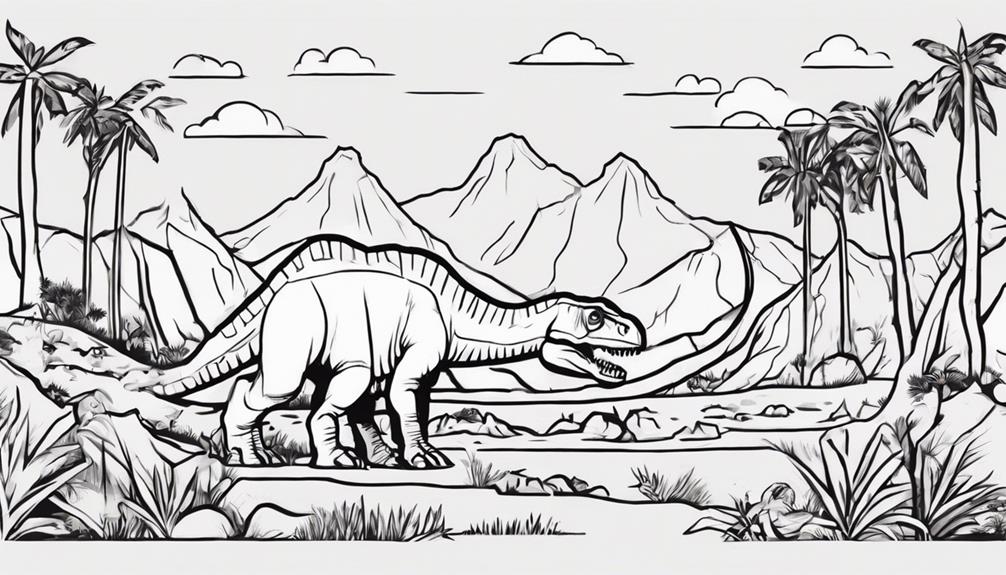
Exacerbated by volcanic activity from the Deccan Traps, climate change played a pivotal role in the extinction of dinosaurs. The interaction between volcanic eruptions and the Earth's climate had profound consequences for the environment in which dinosaurs lived. Here are three key ways in which climate change influenced the extinction event:
- Global Impact: Volcanic gases released from the Deccan Traps altered the global climate by causing significant cooling and acid rain. These environmental changes disrupted ecosystems, leading to food shortages and habitat destruction for dinosaurs.
- Vegetation Changes: The altered climate caused by volcanic activity affected vegetation patterns, leading to widespread deforestation and changes in plant diversity. This, in turn, impacted herbivorous dinosaur populations that relied on specific plant species for sustenance.
- Ecosystem Disruption: Climate change resulting from volcanic activity disrupted the delicate balance of ecosystems in which dinosaurs thrived. Shifts in temperature and precipitation patterns likely contributed to the decline of various species, ultimately culminating in the mass extinction event.
These factors highlight the intricate relationship between climate change, volcanic activity, and the extinction of dinosaurs.
Survival Strategies of Dinosaurs
In response to the challenges posed by the extinction event, dinosaurs employed a variety of survival strategies to persist in a changing world. Some species adapted by becoming smaller to better navigate the harsh post-extinction conditions. The ability of dinosaurs to adapt to changing environments played a crucial role in their survival. Evolutionary changes in behavior and anatomy also helped certain dinosaurs thrive in the altered landscape following the catastrophic event. Additionally, the transition of some dinosaurs into birds allowed them to survive and evolve over time. Herbivorous dinosaurs benefited from the less impacted plant life, providing a food source that helped sustain them through the tough post-extinction period.
| Survival Strategy | Description |
|---|---|
| Size Reduction | Some dinosaurs adapted by becoming smaller to cope with the harsh conditions. |
| Evolutionary Changes | Behavioral and anatomical changes assisted certain dinosaurs in post-extinction survival. |
| Transition to Birds | The evolution of some dinosaurs into birds enabled their survival and continuation. |
| Herbivorous Diet | Access to relatively unaffected plant life supported the survival of herbivorous dinosaurs. |
Extinction Event Timeline
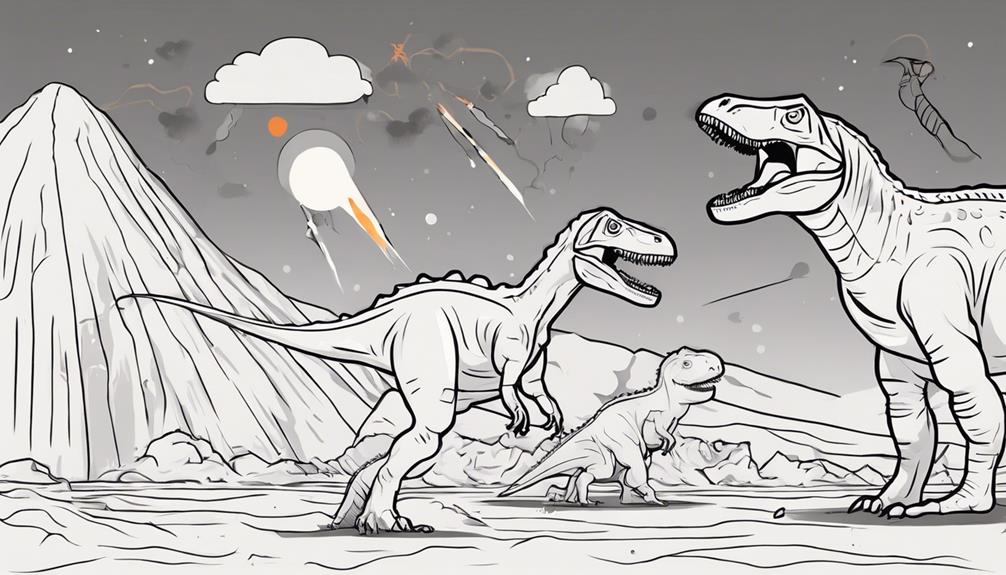
During the transition from the Cretaceous to the Tertiary period, a pivotal event occurred around 66 million years ago that drastically altered the course of evolutionary history on Earth. This mass extinction event, known as the Cretaceous-Paleogene extinction event, is a significant point in the fossil record where numerous species, including the dinosaurs, disappeared. The timeline leading to this catastrophic event involves:
- Alvarez Hypothesis: The Alvarez hypothesis suggests that a massive meteor impact played a crucial role in triggering this mass extinction event. This impact led to widespread environmental changes, including climate fluctuations and disruption of ecosystems.
- Volcanic Activity: Intense volcanic activity during this period also contributed to environmental disturbances, potentially exacerbating the effects of the meteor impact. The release of gases and ash into the atmosphere could have further disrupted the climate and ecosystems.
- Geological Evidence: The fossil record, along with geological evidence such as the Chicxulub crater and iridium-rich layers, supports the theory of a catastrophic event around 66 million years ago. These findings provide insights into the timeline of events leading to the extinction of the dinosaurs and many other species.
Evolutionary Aftermath
Following the catastrophic event that led to the extinction of dinosaurs, surviving species faced significant challenges in adapting to the altered environment. The impact of this catastrophe reverberated across ecosystems, creating new niches and opportunities for evolutionary innovation. The evolutionary aftermath of the extinction event marked a pivotal moment in Earth's history, shaping the course of life for millions of years to come.
Impact of Catastrophe
The catastrophic event that precipitated the demise of dinosaurs catalyzed swift and profound evolutionary transformations in the surviving species. This event marked a pivotal moment in Earth's history, shaping the course of evolution for millennia to come. Following the catastrophe, surviving species, such as birds and mammals, underwent rapid adaptations to fill ecological niches left vacant by dinosaurs. This led to the diversification and proliferation of new species, exploiting the opportunities presented by the altered ecosystem. The evolutionary pressures post-extinction favored small, agile, and adaptable species, contributing to the rise of modern birds and mammals. The impact of this catastrophe reverberated through time, paving the way for the emergence and dominance of new evolutionary lineages.
Adaptation Challenges
In the wake of the catastrophic event that led to the extinction of dinosaurs, surviving species encountered formidable challenges in adapting to the dramatically transformed environment. The shift in ecosystems meant surviving species had to navigate heightened competition for resources, cope with changing food sources, and evade new predators. The extinction of dominant species like dinosaurs created ecological opportunities and pressures for the remaining organisms. This period of adaptation was crucial for the reshaping of existing niches and the emergence of new ones. The survival and evolution of species in the post-extinction world were heavily influenced by the need to quickly adjust to the altered conditions, leading to the diversification and rise of new life forms on Earth.
Environmental Changes
After the catastrophic environmental upheaval that catalyzed the extinction event of dinosaurs, the evolutionary aftermath manifested in significant disruptions to Earth's ecosystems and life forms.
Key Points:
- Climate Change: The environmental changes, such as asteroid impact and volcanic eruptions, altered Earth's climate, leading to drastic shifts in temperature and sunlight availability.
- Ecosystem Disruption: These changes disrupted ecosystems, impacting plant and animal life by altering food sources and habitats, ultimately affecting the survival of many species.
- Extinction Event Impact: The aftermath of these environmental changes affected breeding patterns, survival rates, and the ability of dinosaurs to adapt to the rapidly changing conditions, contributing to their decline and eventual extinction.
Marine Life Impact
Significant repercussions reverberated through marine ecosystems following the extinction event that wiped out the dinosaurs. This cataclysmic event had a profound impact on marine life, leading to the extinction of various species such as marine reptiles and ammonites. The delicate balance of oceanic ecosystems was disrupted, causing ripple effects throughout the food chain. Surviving marine species faced the daunting task of adapting to the drastically altered post-extinction environment.
Marine Life Impact Table:
| Marine Life Impact | Effects |
|---|---|
| Extinction of Species | Marine reptiles and ammonites went extinct. |
| Ecosystem Changes | Shifts in oceanic ecosystems occurred. |
| Food Chain Disruptions | Extinction event led to disruptions in the marine food chain. |
| Survival Challenges | Surviving marine species had to adapt to the new environment. |
The loss of key marine species and disruptions in the food chain had long-lasting consequences on marine ecosystems, shaping the evolution of marine life in the aftermath of the extinction event.
Mass Extinction Patterns
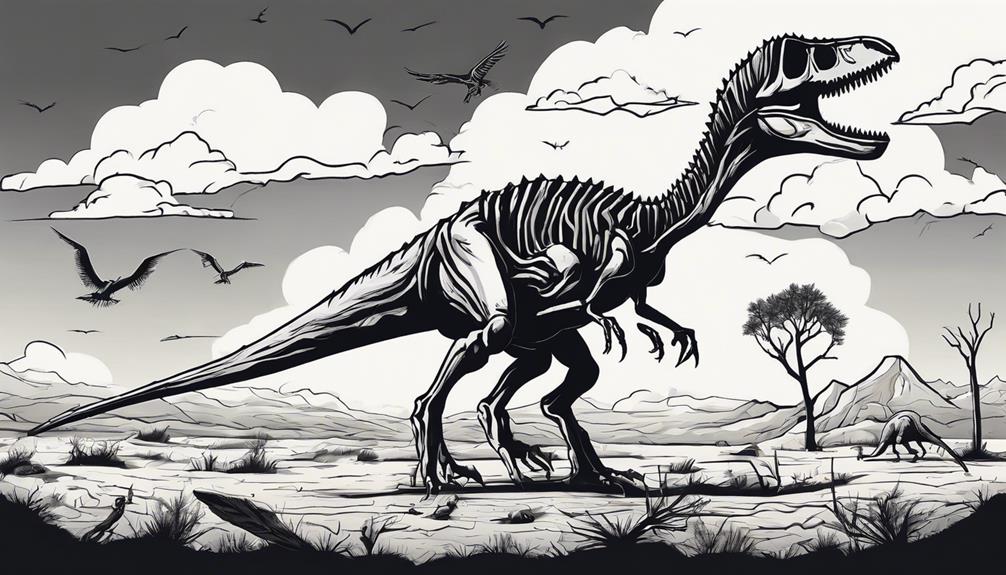
A comprehensive analysis of mass extinction patterns reveals intricate interconnections between environmental upheavals and the dramatic loss of biodiversity across geological time scales. This phenomenon is characterized by significant events that reshape the composition of life on Earth:
- Mass Extinction Event: These events are marked by a rapid and severe decrease in biodiversity, leading to the loss of a substantial portion of species within a relatively short timeframe.
- K-T Boundary: The boundary between the Cretaceous and Paleogene periods, commonly known as the K-T boundary, serves as a prominent marker for one of the most famous mass extinctions in Earth's history, culminating in the extinction of the dinosaurs.
- Asteroid Impact Hypothesis: One prevailing theory proposes that an asteroid impact caused drastic environmental changes, including widespread wildfires, tsunamis, and a "nuclear winter" effect, contributing to the demise of numerous species, including the dinosaurs.
These patterns underscore the critical role of factors such as climate change, asteroid impacts, and ecosystem collapse in shaping the destiny of life on our planet.
Species Interactions
The intricate web of species interactions among dinosaurs played a pivotal role in shaping their population dynamics and ecological resilience. Competition for resources and habitat likely intensified as dinosaur populations grew, influencing their survival rates. Predator-prey relationships between herbivorous and carnivorous dinosaurs would have impacted population dynamics, potentially leading to shifts in ecosystem balance. These changes in interactions could have affected the ability of dinosaurs to adapt to new environmental challenges, further impacting their resilience.
Moreover, interactions with other species, such as plants and smaller animals, would have influenced the overall biodiversity and stability of dinosaur ecosystems. A decline in species diversity and ecological interactions could have weakened the resilience of dinosaur populations, making them more susceptible to extinction events. Understanding these intricate species interactions is crucial for comprehending the complexities that contributed to the extinction of dinosaurs.
Modern-Day Implications
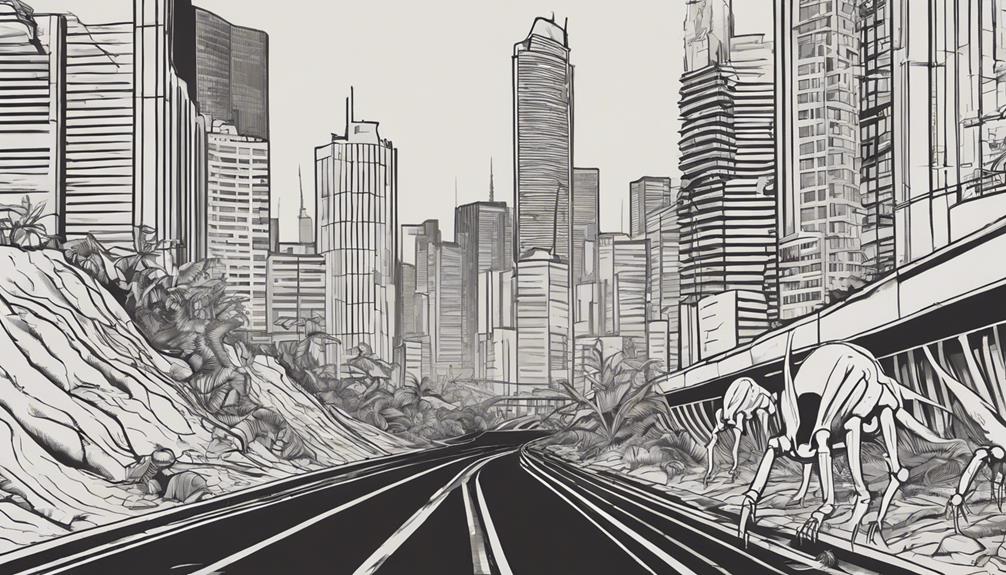
The aftermath of the dinosaur extinction event continues to echo through modern ecosystems, with far-reaching implications for the dominance and evolution of mammalian and avian species. This critical event paved the way for the rise of mammals and birds as the dominant terrestrial vertebrates. Understanding the repercussions of this mass extinction provides significant insights into the dynamics of modern ecosystems and the evolutionary paths taken by surviving species.
Modern-Day Implications:
- Mammals and Birds Domination: The extinction of dinosaurs allowed mammals and birds to diversify and occupy ecological niches previously held by dinosaurs, shaping the current biodiversity we observe.
- Environmental Changes: The environmental changes triggered by the extinction event forced species to adapt rapidly, leading to the development of various survival strategies seen in modern mammals and birds.
- Conservation Efforts: Lessons learned from the dinosaur extinction emphasize the urgent need for conservation efforts to protect vulnerable species and prevent future mass extinctions, highlighting the fragility of ecosystems in the face of global challenges.
Frequently Asked Questions
What Caused the Dinosaurs to Go Extinct?
Climate change, asteroid impact, food scarcity, volcanic eruptions, disease outbreak, genetic mutations, predation pressure, environmental changes, competition, and extinction events are all factors that have been proposed as potential causes of dinosaur extinction. The interplay of these various elements may have led to the demise of the dinosaurs, with some theories suggesting a combination of asteroid impact and volcanic activity as the primary contributors. Further research is necessary to fully understand the complex mechanisms behind the extinction event.
Why Did Dinosaurs Die but Not Other Animals?
Among the array of factors influencing the extinction event, successful adaptation to environmental changes and competition played decisive roles in the differential survival rates of animals. The ability to evolve rapidly and adapt to new conditions, including shifts in food sources and climate, was crucial. While the catastrophic asteroid impact and volcanic eruptions triggered the mass extinction, species that possessed effective survival strategies and evolutionary mechanisms were more likely to endure.
When Did the Last Dinosaur Die?
The last non-bird dinosaurs perished around 66 million years ago, based on fossil evidence. This mass extinction event, known as the K-T extinction, marked the boundary between the Cretaceous and Tertiary periods. The leading theory attributes this extinction to an asteroid impact that caused drastic climate changes. This catastrophic event reshaped the evolutionary timeline, leading to the rise of mammals and birds in the aftermath.
Did Humans Live With Dinosaurs?
Evolutionary evidence, fossil records, and paleontological studies indicate that humans did not live with dinosaurs. Ancient civilizations did not coexist with these ancient creatures as they went extinct approximately 66 million years ago. While cultural myths sometimes depict humans and dinosaurs together, scientific research places the timeline of dinosaur extinction long before the emergence of Homo sapiens. The separation of these timelines is evident in the vast expanse of Earth's history.
Conclusion
In conclusion, the extinction of dinosaurs presents a cautionary tale of the delicate balance of ecosystems and the vulnerability of species to catastrophic events. Just as the mighty dinosaurs fell victim to the forces of nature, so too must we heed the lessons of the past and strive to protect and preserve the diversity of life on Earth. The evolution of surviving species serves as a testament to the resilience and adaptability necessary for survival in an ever-changing world.
